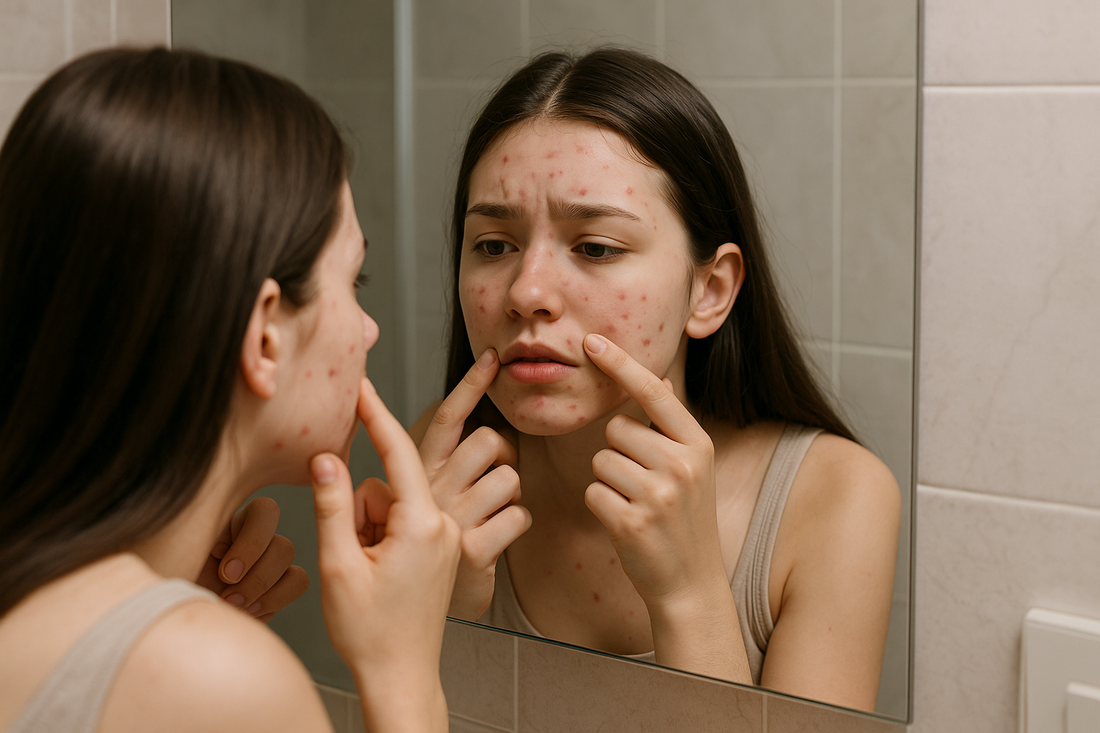Acne Isn’t Just One Condition – Here's What You Need to Know About Its Different Types
We often hear the word "acne," but it’s important to understand that this term covers a variety of skin conditions, each with different causes, appearances, and effects on the skin. In this article, we’ll explore the most common types of acne, their symptoms, and how they can be treated.
1. Acne Vulgaris (Common Acne)
Acne vulgaris is the most prevalent form of acne, typically affecting teenagers during puberty. It’s caused by the overproduction of sebum and hyperactivity of the sebaceous glands, which leads to clogged pores.
Common acne manifests in several ways:
- Open comedones (blackheads): These occur when pores are clogged with excess sebum and dead skin cells, and the contents oxidize upon exposure to air, turning dark.
- Closed comedones (whiteheads): These form when clogged pores are sealed off from air, so the contents remain white.
- Pustules: Small, red, inflamed bumps filled with pus that can be painful.
- Papules: Hard, tender bumps under the skin without pus.
Treatment includes gentle cleansing products, salicylic acid, benzoyl peroxide, and, in more serious cases, prescription medications like retinoids from a dermatologist.
2. Hormonal Acne
Hormonal acne primarily affects women and is linked to hormonal fluctuations such as those during the menstrual cycle, pregnancy, or from using hormonal contraceptives. It typically presents as deep, painful blemishes around the chin, jawline, and lower face.
Treating hormonal acne often involves working with a gynecologist or endocrinologist to balance hormone levels. Topical treatments containing salicylic acid, retinoids, and niacinamide can also be helpful.
3. Rosacea (Often Called Acne Rosacea)
Though it shares the name, rosacea is a different condition. It’s a chronic inflammatory skin disorder that causes facial redness, bumps, and visible blood vessels, particularly on the nose, cheeks, forehead, and chin. Triggers include sun exposure, alcohol, spicy food, and stress.
Managing rosacea involves avoiding known triggers, using gentle skincare products, and often prescription treatments such as metronidazole or ivermectin. In some cases, laser therapy can reduce visible vessels.
4. Cystic Acne
Cystic acne is one of the most severe forms of acne. It involves large, painful cysts deep under the skin, caused by a buildup of bacteria, sebum, and dead skin cells in blocked pores. These cysts are often inflamed and can lead to scarring.
Treatment typically requires stronger interventions like oral antibiotics, isotretinoin (a form of vitamin A), or corticosteroid injections. It’s important not to squeeze these lesions, as it can worsen inflammation and lead to scarring.
5. Mechanical Acne
Mechanical acne is caused by friction, pressure, or excessive sweating, which leads to clogged pores. It commonly affects athletes or people wearing tight clothing, helmets, backpacks, or face masks.
To prevent and treat mechanical acne, avoid friction when possible and use light, non-comedogenic skincare products. Salicylic acid can help keep pores clear.
6. Cosmetic Acne (Acne Cosmetica)
Cosmetic acne results from the use of pore-clogging makeup or skincare products. It often affects those who use heavy foundations, creams, or products with oils and comedogenic ingredients.
Prevention starts with choosing products labeled as "non-comedogenic" and paying attention to ingredient lists. Proper cleansing routines are also essential to remove excess sebum and product buildup.
7. Drug-Induced Acne
Certain medications can trigger acne-like breakouts as a side effect. Common culprits include corticosteroids, some antidepressants, and anti-epileptic drugs. These breakouts resemble regular acne but are directly linked to the medication.
If this type of acne appears, it’s important to consult your doctor about adjusting the medication. Gentle skincare can help manage the symptoms.
8. Stress-Induced Acne
Stress acne is increasingly common, especially among adults. Stress increases cortisol levels, which in turn stimulates sebum production and leads to breakouts. These often appear around the lower face, forehead, and mouth.
Managing stress-related acne involves emotional wellness, healthy routines, regular exercise, and a balanced skincare regimen. Anti-inflammatory and sebum-regulating products may also be effective.
How to Prevent and Manage Different Types of Acne
While each type of acne has its own cause, several universal skincare principles can help prevent and manage symptoms:
- Proper Cleansing – Wash your face twice a day with gentle cleansers that remove excess oil and dirt without stripping the skin.
- Hands Off – Avoid touching your face to reduce the spread of bacteria and irritation.
- Non-Comedogenic Products – Use makeup and skincare that won’t clog pores.
- Hydration Matters – Acne-prone skin still needs moisture; opt for lightweight, non-greasy moisturizers.
- Healthy Lifestyle – A diet rich in vegetables, fruits, and healthy fats, along with regular exercise and good sleep, can improve skin condition.
- Stress Management – Incorporate relaxation techniques like meditation or mindfulness to help reduce acne triggered by stress.
Understanding the type of acne you're dealing with is key to effective treatment and skincare. Since each form has its own characteristics and needs, accurate identification and, if needed, consultation with a dermatologist are essential. With the right knowledge and care, you can take control of your acne and enjoy healthier, more radiant skin.

